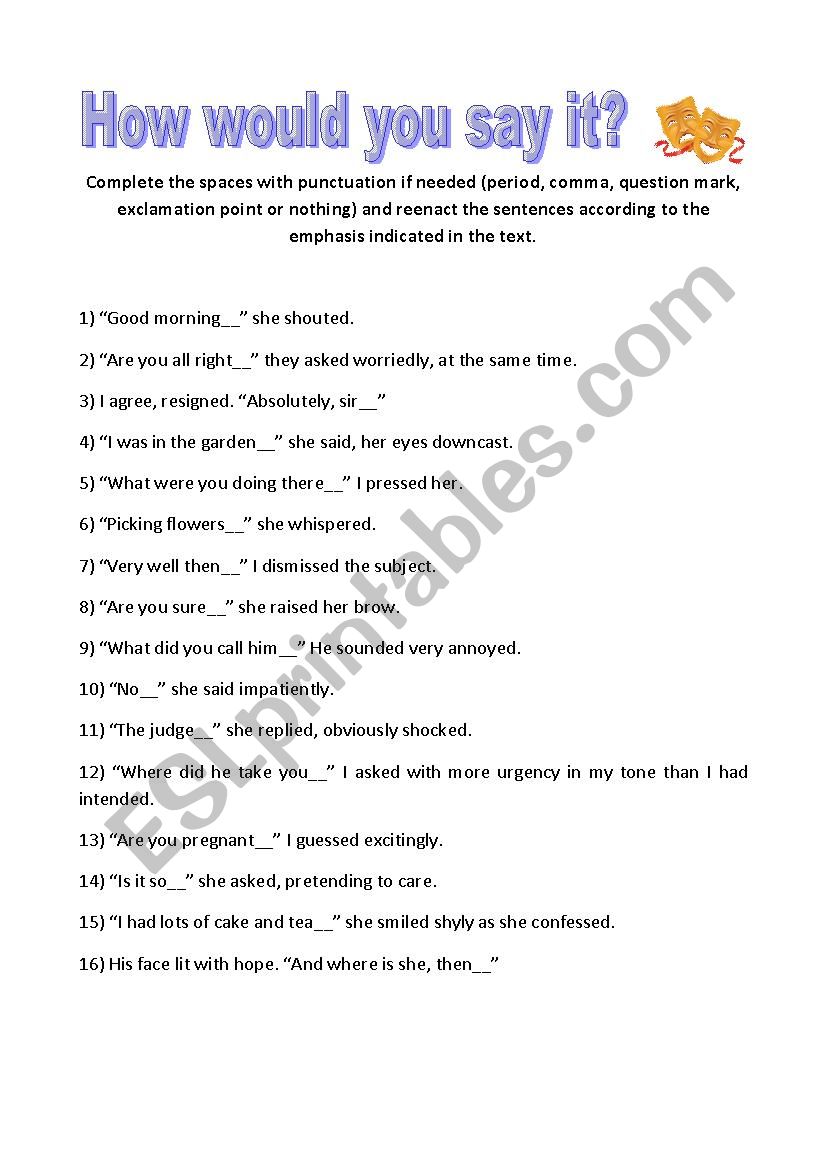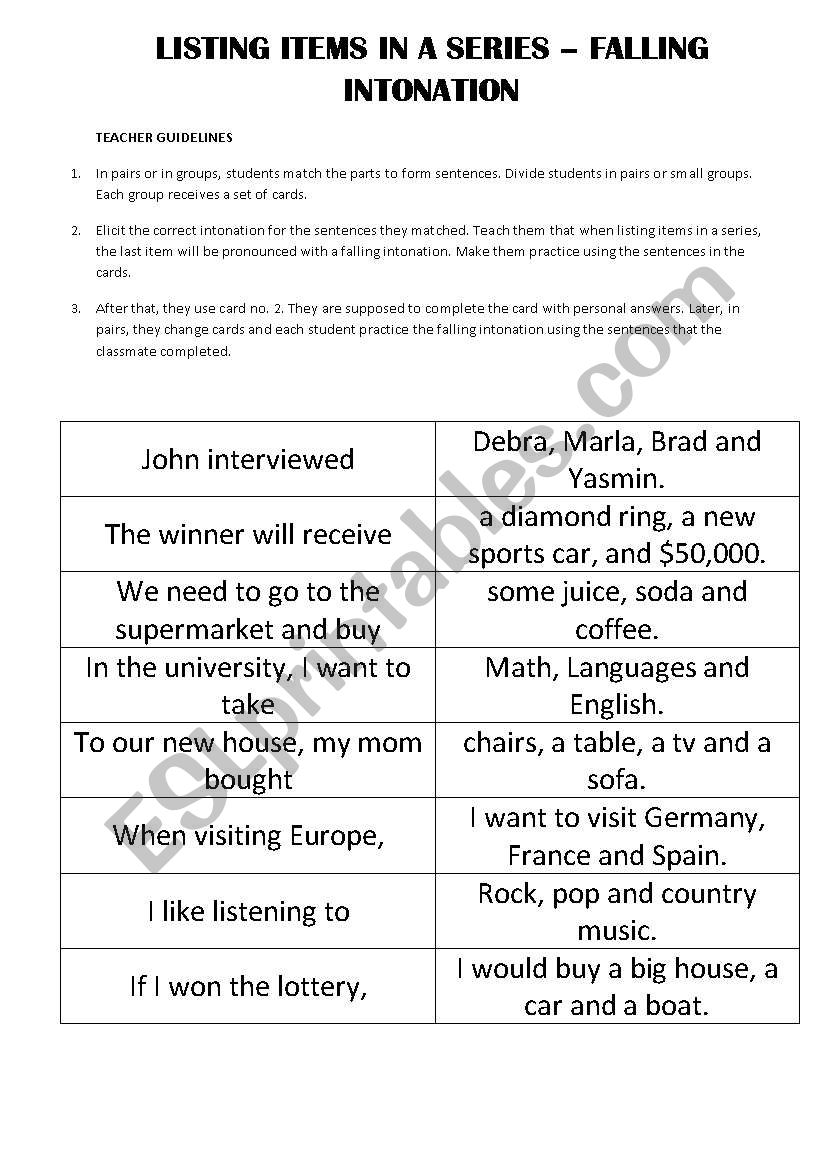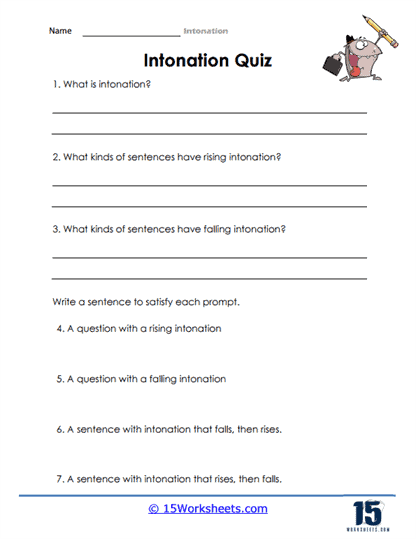
Mastering the Melody of English: The Indispensable Role of Intonation Worksheets
English, a language celebrated for its global reach and intricate nuances, presents a fascinating challenge to learners worldwide. While much focus is often placed on vocabulary, grammar, and individual sound pronunciation, there’s a vital, often overlooked, element that truly brings the language to life: intonation. Intonation, the rise and fall of the voice when speaking, is the melody of English, conveying meaning, emotion, and grammatical structure. For learners striving for fluency and naturalness, mastering this aspect is paramount, and this is where well-designed intonation worksheets emerge as invaluable tools.
This article delves into the profound importance of intonation, explores the unique benefits and characteristics of effective intonation worksheets, and provides practical strategies for both learners and educators to leverage these resources for enhanced communication.
The Unseen Power of Intonation: More Than Just Words

Imagine saying "You’re coming?" versus "You’re coming." The exact same words, yet the meaning shifts dramatically due to intonation. The first, with a rising pitch at the end, is a question seeking confirmation. The second, with a falling pitch, is a statement of fact or an assumption. This simple example underscores intonation’s critical role.

Intonation serves several key functions in English:
- Conveying Meaning and Emotion: It can express enthusiasm, boredom, surprise, doubt, anger, or politeness, even with neutral words. "Oh really?" can be genuine interest or sarcasm, depending on the intonation.
- Distinguishing Sentence Types: Rising intonation often signals questions (especially yes/no questions), while falling intonation typically marks statements, commands, and Wh-questions (who, what, where, when, why).
- Highlighting New Information: Stressing certain words within a sentence using higher pitch or volume draws attention to them, indicating new or important information. "I bought the book" implies I didn’t borrow or steal it.
- Signaling Speaker Intent: It can indicate whether a speaker has finished their thought (falling intonation) or if they intend to continue (rising or fall-rise intonation).
- Creating Rhythm and Naturalness: Proper intonation contributes significantly to the overall rhythm of English, making speech sound fluid and native-like, rather than flat or robotic.



Given its multifaceted role, it becomes clear that without adequate intonation, even perfect grammar and vocabulary can lead to misunderstandings, awkward interactions, and a general lack of confidence for the speaker. This is precisely why targeted practice, often facilitated by structured materials, is essential.
The Indispensable Role of Intonation Worksheets

While listening to native speakers is crucial for developing an ear for intonation, passive listening alone often isn’t enough to internalize and reproduce these complex patterns. Learners need focused, active practice, and this is where intonation worksheets truly shine. They offer a structured, systematic approach to dissecting and mastering the musicality of English.
Here’s why they are so valuable:

- Structured Practice: Worksheets break down intonation into manageable components, focusing on specific patterns (e.g., rising, falling, listing, choice questions) in isolation before integrating them.
- Active Engagement: They require learners to actively listen, identify patterns, mark sentences, or produce their own intonation, moving beyond passive reception.
- Visual Representation: Many worksheets use arrows, lines, or other visual cues to represent pitch changes, helping learners "see" the intonation, which is often difficult to perceive solely by ear.
- Self-Paced Learning: Learners can work through materials at their own speed, revisiting difficult sections as needed, making them ideal for self-study or as supplementary homework.
- Reinforcement and Repetition: Worksheets provide ample opportunities for repetitive practice, which is vital for developing muscle memory in the vocal cords and brain pathways responsible for intonation.
- Bridging Theory and Practice: They take abstract concepts of intonation rules and apply them to concrete examples, helping learners understand how the theory translates into actual speech.
- Measurable Progress: By completing exercises and checking answers, learners can track their progress and identify areas that still require more attention.

Anatomy of Effective Intonation Worksheets
Not all intonation worksheets are created equal. The most effective ones incorporate several key features that cater to different learning styles and provide comprehensive practice:
-
Clear Explanations and Examples: A good worksheet starts by clearly defining the intonation pattern it focuses on (e.g., "Falling Intonation for Statements") with simple, illustrative examples. It might explain the grammatical contexts or emotional nuances associated with that pattern.
-
Audio Components (Crucial!): This is arguably the most vital element. Intonation is an auditory phenomenon, and learners must hear native speakers model the patterns correctly. Worksheets should be accompanied by high-quality audio tracks for all examples and exercises. This allows learners to:
- Listen and identify the target pattern.
- Repeat and imitate the pattern (shadowing).
- Compare their own pronunciation to the native model.
-
Varied Exercise Types: A range of exercises keeps learners engaged and targets different skills:
- Identification/Listening Tasks: Learners listen to sentences and mark the intonation pattern (e.g., drawing an upward or downward arrow at the end, identifying stressed words).
- Repetition/Shadowing: Learners listen to a sentence and then repeat it, trying to match the intonation of the speaker. Recording oneself and comparing to the original audio is highly beneficial here.
- Sentence Completion/Transformation: Learners complete sentences or rephrase them, applying the target intonation pattern based on the context or desired meaning.
- Dialogue Practice: Short dialogues where learners practice intonation in a conversational context, understanding how it influences turn-taking or emotional exchange.
- Contextual Application: Exercises that require learners to express specific emotions (e.g., surprise, doubt, excitement) through intonation, using provided sentences.
- Listing/Choice Intonation: Specific exercises for these common patterns, where intonation rises on items in a list and falls on the last, or rises on the first choice and falls on the second.
-
Visual Cues: Beyond just arrows, some worksheets use lines that mimic the pitch contour, bolding for stressed words, or color-coding to highlight intonation features. These visual aids can be very helpful, especially for visual learners.
-
Answer Keys: For self-study, a comprehensive answer key is essential. It allows learners to check their understanding and correct their mistakes independently. For exercises involving production (speaking), the answer key might refer back to the audio file for self-assessment.
-
Progressive Difficulty: Effective intonation worksheets typically follow a logical progression, starting with basic patterns (falling for statements, rising for yes/no questions) and gradually introducing more complex ones (fall-rise, stress shifts, intonation in tag questions).
Practical Applications: How to Maximize the Benefit of Intonation Worksheets
Whether you are a self-learner or an educator, there are effective strategies to get the most out of intonation worksheets:
For Learners:
- Active Listening is Key: Before attempting to speak, listen to the audio examples multiple times. Try to really hear the subtle changes in pitch.
- Record Yourself: Use your smartphone or computer to record your own voice when practicing. Play it back immediately after the native speaker’s audio to compare and identify discrepancies. This is arguably the most effective way to self-correct.
- Exaggerate at First: When you’re first trying to produce a new intonation pattern, don’t be afraid to exaggerate it. Over-articulating the rise and fall can help your vocal muscles get used to the movement. You can refine it later.
- Practice in Context: Don’t just practice individual sentences. Try to integrate the intonation patterns into your daily conversations. The more you use them in real-world contexts, the more natural they will become.
- Regular, Short Sessions: Consistency is more important than duration. Ten to fifteen minutes of focused intonation practice daily is more effective than one long, infrequent session.
- Don’t Fear Mistakes: Intonation is subtle, and mastering it takes time. Embrace mistakes as learning opportunities.
For Teachers:
- Integrate with Pronunciation Lessons: Use worksheets as a core component of your pronunciation lessons, not just an afterthought.
- Model Clearly: Always model the intonation patterns yourself, in addition to using the audio files. Your students will benefit from hearing it directly from you.
- Pair and Group Work: Encourage students to practice dialogues or read sentences to each other, paying attention to intonation. Peer feedback can be very valuable.
- Use Role-Plays: Design role-playing scenarios where specific emotions or intentions need to be conveyed through intonation.
- Diagnostic Tool: Use initial worksheet exercises as a diagnostic tool to identify common intonation challenges among your students and tailor your instruction accordingly.
- Create Your Own: While many excellent pre-made intonation worksheets exist, consider creating custom ones that address the specific needs and common errors of your students, using relevant vocabulary and contexts.
Beyond the Worksheet: Integrating Intonation into Holistic Learning
While intonation worksheets are a powerful foundation, they are a means to an end: natural, effective communication. To truly master intonation, learners must extend their practice beyond the confines of structured exercises.
Encourage learners to:
- Listen Actively to Everything: Pay attention to intonation in movies, TV shows, podcasts, news broadcasts, and everyday conversations. Try to identify the patterns and how they contribute to meaning.
- Engage in Real Conversations: The best way to solidify intonation is to use it in genuine interactions. Don’t be afraid to speak, even if you feel uncertain.
- Focus on Rhythm and Stress: Intonation is closely linked to English rhythm and word/sentence stress. A holistic approach to pronunciation will address all three interconnected elements.
- Be Patient and Persistent: Mastering intonation is a journey, not a destination. It requires consistent effort and a keen ear.
Conclusion
Intonation is the soul of spoken English, transforming mere words into meaningful expressions. It’s the key to sounding natural, avoiding misunderstandings, and communicating with confidence and clarity. For learners navigating the complexities of English pronunciation, intonation worksheets serve as indispensable guides. By providing structured practice, clear explanations, vital audio components, and varied exercises, these resources empower individuals to systematically dissect and master the melodic patterns of the language.
Whether used for self-study or as a cornerstone of classroom instruction, the strategic application of these worksheets, combined with active listening and real-world practice, will undoubtedly elevate a learner’s English proficiency from merely understandable to truly articulate and engaging. Embracing the melody of English through dedicated intonation practice is a significant step towards achieving genuine fluency and connection.
